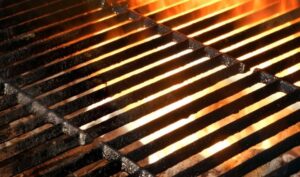BBQ Cooking Tips
There are heaps of ways Aussies enjoy BBQs all year round.
When the sun is shining, you know it’s time to ready the BBQ.
Australian BBQs are a tradition where friends and family gather for good times and good food outdoors.
Men and women more than ever are picking up the tongs and turning the snags and steak on the hotplate.
Here are twelve handy grilling tips and hacks to ensure your BBQ recipes are a success.
1. Season the BBQ grill or hotplate before use
Coat the charcoal grill or gas BBQ cooking surface with cooking oil using a brush or spray.
Close the barbecue and allow it to pre-heat for five or ten minutes then wipe the cooking surface clean with a fresh damp cloth.
Avoid using olive oil or other oils that don’t tolerate high heat.
You should always season the BBQ grill.
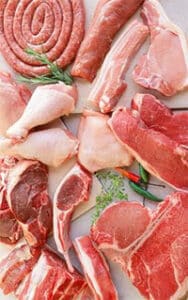 2. Practice food safety when using a gas BBQ
2. Practice food safety when using a gas BBQ
Keep raw meat and other perishables clean and cold until you are ready to BBQ.
Keep everything on ice and make sure you have plenty of dishes and containers so there is no cross-contamination between cooked food and uncooked meat.
Only allow frozen meat to thaw to room temperature when you are ready to cook it.
3. Sear meats from the outside in.
Place steaks and sausages directly over the grill grates when gas barbecue cooking.
Brush a little oil on the cuts of meat to prevent sticking.
Using a little coarse salt and coarse black pepper can create a tasty crust.
BBQ patties, buns, and tender veggies are usually cooked on the hotplate rather than the grill.
4. Crosshatching and searing
Heat the gas BBQ grill prior to cooking meat so the grill is ready to sear the meat at a high temperature and lock in the juices.
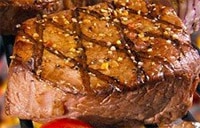 Take the meat out of the refrigerator 15 minutes before cooking.
Take the meat out of the refrigerator 15 minutes before cooking.
Turn the heat down to the level suited for your recipe then sear the meat for 90 seconds on high heat.
Rotate the meat 1/8 of a turn (45 degrees) and sear again.
This will create an attractive crosshatch pattern that also works to seal in brisket juices.
Reduce the heat to normal cooking temperature after searing.
5. Only turn the meat once
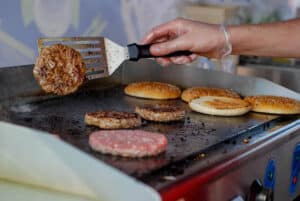 Although this cooking method advice is debated by many, it is followed by leading BBQ chefs who strictly follow the rule.
Although this cooking method advice is debated by many, it is followed by leading BBQ chefs who strictly follow the rule.
Don’t overcrowd the grill when using your gas BBQ or it can heat unevenly.
It’s a good idea to trim fat off meats before cooking to avoid flare-ups.
Make sure you have enough gas so your cooking time is uninterrupted.
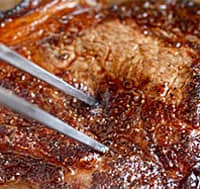 6. Avoid poking holes with BBQ forks
6. Avoid poking holes with BBQ forks
To retain the natural juices, don’t poke holes in the meat when using a BBQ.
This includes piercing the sausage skin with skewers or a BBQ fork. Use long-handled tongs or spatulas instead of forks.
7. Let the meat rest after cooking
Let your grilled piece of meat ‘rest’ for five minutes after BBQ cooking, covered loosely with foil, to ensure even more tender and juicy results.
This suggestion applies to roasts and other hot grill BBQ-cooked meats also.
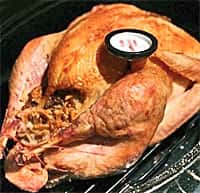 8. Away from the burner BBQ cooking
8. Away from the burner BBQ cooking
Whole chickens, roasts, and most fish fillets require indirect heat when cooking on a gas grill BBQ.
Consider upgrading to an LPG barbecue that can effectively work as an oven or a grill on medium-high heat.
9. Use foil for BBQ cooking
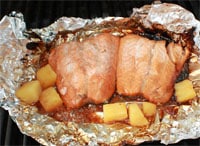 You can use aluminium foil to create little cooking pouches for delicate foods such as fish fillets using a gas BBQ.
You can use aluminium foil to create little cooking pouches for delicate foods such as fish fillets using a gas BBQ.
Cook away from direct flame, or place the pouch on the BBQ cooking warming rack, if you have one.
10. Reheating Pizza using a BBQ grill
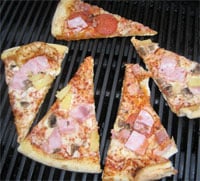 Did you know that using a gas BBQ grill is the perfect way to cook reheated pizza?
Did you know that using a gas BBQ grill is the perfect way to cook reheated pizza?
Just set the BBQ on low or medium heat, preheat, put the pizza directly on the grill, and close the lid.
Heat until the cheese starts to melt. You will get more even heating with the lid down.
11. Flavour meats with marinades
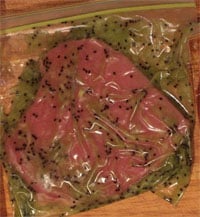 For more intense or varied flavours, consider using meat marinades and BBQ sauce for BBQ cooking.
For more intense or varied flavours, consider using meat marinades and BBQ sauce for BBQ cooking.
You can marinate meat in a freezer bag. Simply add your marinade recipe to the bag, add your meat, seal the bag, and shake.
Refrigerate, shaking occasionally, until you are ready to BBQ.
Drain off the excess marinade before cooking. Don’t pour it over the meat while cooking.
12. Clean the grill while it is still warm
Allow the BBQ grill to cool down a little, then while wearing protective gloves, clean the BBQ grill while it is still relatively hot.
Use a good grill brush to clean the BBQ cooking plates and racks.
Lightly coat cooking surfaces with cooking oil when clean.
Remember to empty the grease tray for a completely clean grill ready for your next great BBQ.
Click for the Free E-Book Download
The Eco-Friendly BBQ Choice
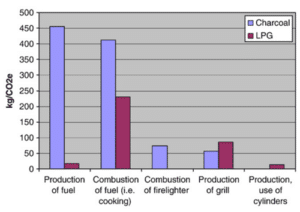 When it comes to BBQ grilling, LPG is the eco-friendly choice.
When it comes to BBQ grilling, LPG is the eco-friendly choice.
Not only does LPG emit less CO2 than charcoal, but it is also easier and more convenient to use.
Find out about Elgas SWAP’n’GO gas bottles for BBQs, camping, and the outdoors.
Elgas is also Australia’s favourite provider of LPG for home and LPG for business, so contact Elgas online or over the phone today and make the switch to cleaner, more environmentally-friendly LPG energy.
New Residential LPG customer?
New Business LPG customer?
Existing ELGAS customer?
- Butane – Butane Gas – Butane Chemical Formula- Butane Gas Canister - April 23, 2025
- BBQ – Gas and Charcoal BBQ Features – Charcoal BBQ vs Gas BBQ Comparison - March 31, 2025
- GPL Gas (GPL Fuel) – GLP Gas – LPG Gasul: GLP – GPL Station Near Me - March 26, 2025
Steve Reynolds
Technical Consultant
Steve Reynolds is a leading expert in the LPG industry with over 22 years of experience. As part of the national management team at ELGAS, Steve ensures the safe and efficient storage, handling, and transportation of LPG. He serves as the lead investigator for incidents and collaborates with authorities on industry developments.
Steve is a technical advisor to Standards Australia and Gas Energy Australia (GEA), and an active member of the World LPG Association (WLPGA), contributing to global standards and technical reviews. He holds a BSc. (Hons) in Industrial Chemistry from UNSW and has held senior safety and technical roles at ELGAS, making him a trusted authority in LPG safety and standards.

